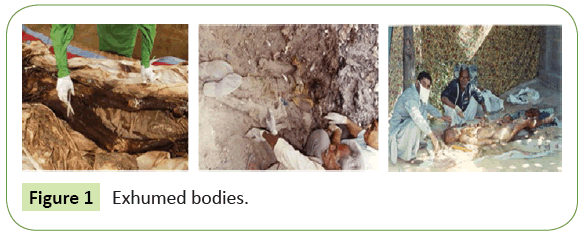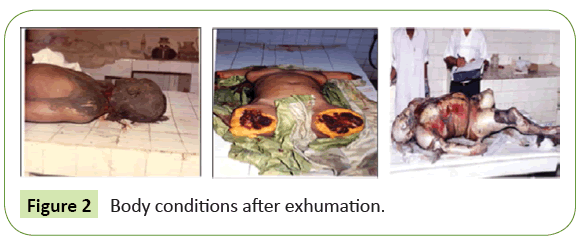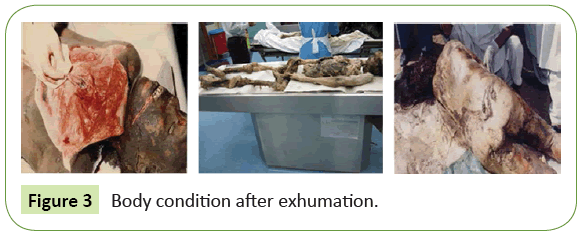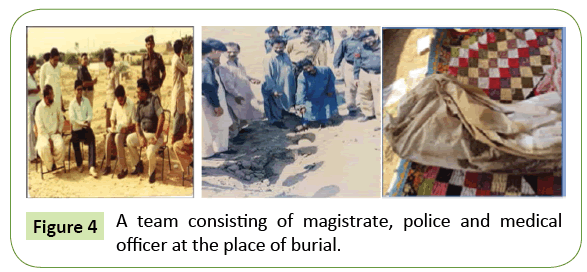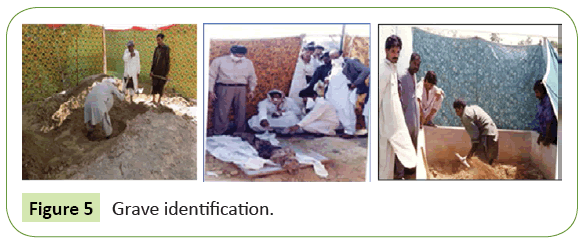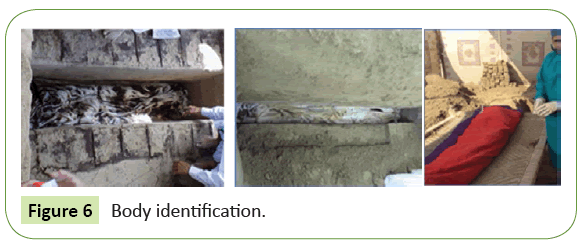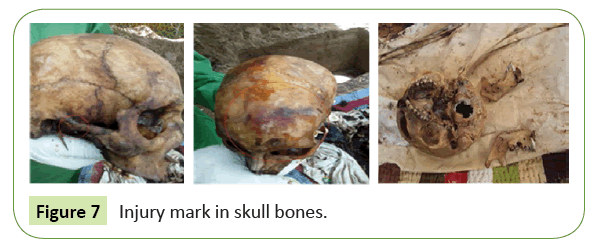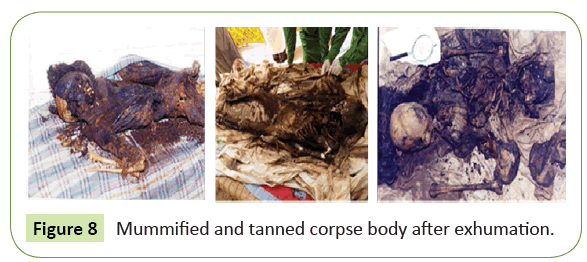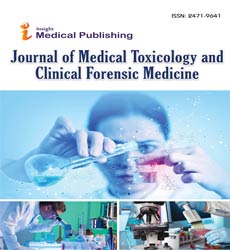Whether Dead Men Really do Tell Stories - A Study on Tales From the Graves
Anshoo Agarwal, Shafi Nizamani and Hala Abdel Dayem Mouhammed
DOI10.21767/2471-9641.100027
1Department of Pathology, Faculty of Medicine, Northern Borders University, Kingdom Saudi Arabia
2University Technology MARA, Malaysia
3Department of Pathology, Faculty of Medicine, Suez Canal University, Ismailia, Egypt
- Corresponding Author:
- Mouhammed HA
Department of Pathology
Faculty of Medicine, Suez Canal University, Ismailia, Egypt
Tel: 00965051425
E-mail: hala.abdeldayem@yahoo.com
Received date: April 20, 2017; Accepted date: September 17, 2017; Published date: September 24, 2017
Citation: Agarwal A, Nizamani S, Mouhammed HAD (2017) Whether Dead Men Really do Tell Stories - A Study on Tales from the Graves. J Med Toxicol Clin Forensic Med. Vol. 3 No. 1:7
Abstract
Background: Exhumation is a process by which the already buried dead body is taken out by digging under the law of the land. Aim: To analyze and evaluate the findings seen in exhumed bodies and the factors which play role in decomposition of a corpse. Material & methods: Study was conducted in different districts of Sindh on exhumed dead bodies of different Age, Sex and religion.
Keywords
Exhumation; Grave; Dead bodies; Autolysis; Facial identification; Adiopocere
Introduction
Exhumation is the removal of the corpse from its grave for determination of the cause of death [1]. Exhumation is a Latin word, which means ‘from the ground’. Exhumation is performed after authorization from “Judicial Magistrate” or appropriate authority [2].There are so many other religious [3] cultural and social reasons on basis of which exhumation is carried out in the different part of the world.
The religion of Islam has its own reservations regarding exhumation and autopsies of dead bodies. Exhumation is defined as “Lawful digging out of a buried body from its grave”. It is necessary for:
❏ Purpose of body identification.
❏ To determine the cause of death when foul play is suspected.
❏ For a second autopsy when first is ambiguous [4].
❏ Reburial at a different place.
In Pakistan under section 176 Cr.P.C. (Code of criminal procedure) Magistrate, order for the exhumation in cases of suspected death or foul play. There is no time limit for exhumation in Pakistan.
Mostly bodies are disinterment “Exhumed” for the following reasons:
❏ To confirm the individuality for any criminal or civil purpose arising after the burial.
❏ Investigation for Homicide and Suspected Homicidal poisoning.
❏ To establish the cause of death: when any foul play is suspected.
❏ Exhumation ordered depending upon the public demand or request by the relatives.
❏ Ordered in the suspected cases disguised as suicide.
❏ When death results from Criminal abortion.
❏ For identification of an exhumed body from the body of some other person thought to have been deceased.
❏ Identifying war victims.
❏ Identifying accidental deaths and to settle the accidental deaths related issue.
❏ For the purpose of insurance coverage.
❏ Liability claim for malpractice negligence or offenses.
❏ To search for foreign objects buried along with dead bodies.
Limitations of exhumations
❏ Time laps between burial and concealment.
❏ Soft tissue findings may be destroyed.
❏ Histopathology findings may be useless.
❏ Vegetable, volatile, synthetic poisons may be lost.
❏ Grave may not be properly identified.
❏ Soil condition may be dry, hot or water lodged.
Post-mortem studies are crucial in forensic sciences for both helpful identification and rebuilding of perimortem events. However, reliable information about the facts poses a scientific challenge since human remains decomposition involves a set of complex and highly alterable courses. Many of studies have been done in the past but still, there is limited information to analyze human body decomposition modalities in different environments.
In order to analyze the post-mortem factors associated with the different stages of decomposition displayed by the 53 exhumed individuals, the stages of decomposition were scored (Figures 1-3). Information regarding age at death and sex of the individuals were gathered and recorded as well as data on the cause of death and grave and coffin characteristics. Studies have shown findings because of death due to cardiac lesions even after 1 year of burial [5].
Although the observed distinct decay stages may be explained by the burial conditions, individual endogenous factors also play an important role in differential decomposition as had been witnessed in various studies. Existing information available in the textbooks of Forensic Medicine & Toxicology is not only inadequate and does not have authentic scientific references. Hence it is necessary to develop scientific reference criteria for the future generation.
Aims of the Study
To analyze and evaluate the findings seen in exhumed bodies and the factors which play role in decomposition of a corpse.
Objectives
• To study exhumation process, digging time, depth of burial, the posture of the body and the interval between death and burial.
• To analyze the duration of pathological findings persisting after burial.
• To correlate the demographic details and pathological findings seen on exhumation.
Materials & Methods
A two years retrospective study was conducted on exhumed dead bodies of different age, sex and religion in different districts of Sindh, Pakistan. A team consisting of magistrate, police and medical officer reached the place of burial. Sampling including earth, cloth, and wood of coffin and earth were collected from above beneath and both sides of the coffin and control samples were taken from the area in the cemetery, away from the grave. Autopsies were performed directly after exhumation or the following day at the latest. All the cases exhumed were as per the requirement from the legal authorities.
Results
A total of 53 dead bodies were exhumed during our study period and the different forensic findings were analyzed from the available records. Total of 53 dead bodies exhumed. Out of them, 34 were males and 19 were females. Only 2 cases were below ten years, 28 cases age group was between 20-30 years and 5 cases were more than 40 years of age. Only 12 out of 53 were Non-Muslims (Table 1). The exhumation was carried out for the graves after two months to two years of dead bodies’ burial, in the presence of a judicial body; on legal demand. It was noted that the interval between death and burial affects the rate of decomposition. In the cases where the cause of death was not found, soil and decomposed soft tissues were preserved. Duration of skeletonization to occur was found to be 2 to 3 months. Most of the dead bodies were in an advanced state of decomposition.
| Cases’ Characteristics | No. (53) | % | |
|---|---|---|---|
| Sex | Male | 34 | 64.2 |
| Female | 19 | 35.8 | |
| religion | Muslims | 41 | 77.4 |
| Non-Muslims | 12 | 22.6 | |
| Age (years) | 11-20 | 12 | 22.6 |
| 21-30 | 15 | 28.4 | |
| 31-40 | 18 | 34.0 | |
| ≥ 40 | 8 | 15.0 | |
| Time between the death and exhumation (months) | 1-3 | 24 | 45.3 |
| 4-6 | 15 | 28.4 | |
| 7-12 | 9 | 17.0 | |
| 13-18 | 2 | 3.7 | |
| 18-24 | 2 | 3.7 | |
| ≥ 24 | 1 | 1.9 | |
| Facial identification | Possible | 3 | 5.7 |
| Not possible | 50 | 94.3 | |
| Changes observed in exhumed bodies | Putrefaction | 32 | 60.4 |
| Mummification | 7 | 13.2 | |
| Adiopocere | 1 | 1.9 | |
| Skeletonized | 13 | 24.5 | |
| Manner of death | Detected | 45 | 85.0 |
| Not detected | 8 | 15.0 | |
| Cause of death | Detected | 17 | 32.1 |
| Not detected | 36 | 67.9 | |
| Seasonal conduction of exhumation | Detected | 17 | 32.1 |
| Not detected | 36 | 67.9 | |
Table 1: Cases' characteristics.
Due to the advanced stage of decomposition, the mark of violence at soft tissue was lost. Organs were also in a state of putrefaction, so histopathology did not give too much about the cause, of death. Most of the deaths were due to the social causes. Facial identification was only possible in cases that were exhumed within 1 month; otherwise, facial identification was lost. The forensic finding of violence was found to be lost after 2-3 months due to autolysis. The average depth of burial was 3.58 feet; the posture of the body in 97% was horizontal. The manner of death was identified in 84.5% of cases manner of death.
Discussion
Often it is said that the exhumation is the futile exercise in the law, wherein the cause of death remains undetermined and at the most, it may help to confirm that death of missing person or alleged dead person. During the present study in the process of exhumation in all the cases, a judicial magistrate was present at the time of exhumation (Figures 4-6). Arrangements of exhumation within the graveyard are the duty of Police and investigating Police official in most of the places. A team consisting of duty magistrate, area police, and nominated medical officer reached the place of burial in the early hours of the morning for exhumation in the present study. As per the law of Pakistan, the medical team first reach the police station and they inform the police and police inform the judge and after the completion of formalities, exhumations will start and same was done in our study also. Studies have shown that only in 22.22% of cases Doctor decided the date 3-6 days prior to the exhumation. In 16.66 % of cases, Doctor was called/rather compelled to come to exhumation site on the same day.
Most of the exhumations are attended by non-forensic personnel hence the legal procedure of exhumation and meticulous examination of the dead body are lacking and literature is silent regarding it. In many countries, the law of the land does not mention about the period during which an exhumation is allowed and no judicial verdict in this regard is there.
In the present study 50% of exhumation were done in the midday, i.e., 11.30 am to 1.30 pm, 40% cases were done after 1.30 pm, i.e., evening hours, 10% were done before 11 am morning. Only in two cases, exhumation was deferred to next day after incomplete digging due to bad light. In our study duration varied from 2 months to 2 years. A majority of the exhumations occurred were done within the first 3 months after death. Exhumations performed after 2 year's burial times were rare. Other studies have reported similar data like the present study in regards to the duration between burial time and the exhumation [4]. Our study was in Pakistan where there is no law for any time limit for exhumation. In the present study, average duration of exhumation i.e. time required for digging out the buried body was around 45 min, the minimum was 15 min in one case, while 180 min in another case, wherein the exhumation was adjourned to next day due to bad light & want of Forensic Medicine expert.
The present study reveals that often the burial grounds were of loose soil & the average depth of grave was 3.58 ft. About 97% cases were buried in the horizontal posture, among which 7 cases were homicides and accidental & suicidal were two cases and one case each. In 2 cases, the dead body was buried in a bizarre manner and all these cases were of homicides.
In this study, two dead bodies were exhumed due to suspected homicide. In these cases, multiple wounds were found over the body remains supporting the allegation made. Exhumations were held almost round the year but a relative more number of cases were done in the month of October to December in the present study.
To what extent exhumation will solve the questions raised is the debatable issue [2], at least it will put an end to rumors' as to the suspicion of the death of the said missing person [6] and find an answer to many medico-legal issues. There is no linear relationship that exists between the times a corpse has remained buried to the degree of decay [7]. There are also no confirmed studies to show the maximum time limit for the particular pathological findings which might still be detected [8]. Various studies have shown that the facial identification of corpse in most cases is not possible. Same findings were observed during our study. In our study, facial identification was only possible in cases that were exhumed within 1 month; otherwise, facial identification is lost. Studies have also shown that most of the exhumed bodies are usually in advanced stages of purification. In the present study, also most of the bodies were present in the advanced stage of decomposition (Figures 1-3). The cause of death can be ascertained after seeing the findings in the vital organ or systems which are composed of soft tissues and the success about the findings leading to the definite diagnosis of the cause of the death depends upon the condition of the corpse. In the present study, it is observed that most of the soft tissues were autolyzed and was not of much help to ascertain the cause of death. The forensic finding of violence was lost in the bodies exhumed after two to three months.
In our study in 32 % cases, the definitive cause of death was found. Head injury was most common finding which was found in 35 % of cases (Figure 7). Head/neck wounds in 12%, head & chest wounds in 18% and chest & abdomen wounds in 2% cases.
In our study in 24.5% cases bodies were found to be skeletonized (Figure 8). Earlier studies have shown that for skeletonization to occur in the burial ground the mean post-mortem interval is 2 to 3 months. As per Casper's dictum in forensic pathology, more than 8 weeks are required for this change to occur. Amongst others, the burial practice and postmortem interval are major determining factors for the possible outcome at exhumation. And also, the bones themselves give an idea of elapsed time by presence or absence of ligamentous attachment and in the rates of leaching out of fats & other organic matter.
We also analyzed that diseases associated with the proliferation of connective tissue and calcium deposits were detectable longer after burial than acute illnesses were. Detection of an acute myocardial infarction can be problematic even a short time after burial. Karger et al. [5] were able to study findings of an acute myocardial infarction even after 1 year of burial. Studies have shown that detection time can be significantly lengthened through the use of immunohistochemical markers resistant such as C5b-9 and NP57 [7]. Other than few isolated cases, it was not possible to evaluate findings in individual organs in our cases after a maximum of approximately 2 years of duration.
During exhumation, it is important that the sampling includes the much possible sample from cloth and wood of coffin, and make sure that the earth samples are collected from above, beneath and both sides of the coffin and control samples are collected from the remote area as well in the cemetery, away from the grave. If the coffin has fluid, it should also be collected. In our study samples were collected as mentioned above.
Our study was limited to the factors which were most easily identifiable (duration of time the body had been buried, age at the time of death, gender, season at the time of death and condition of the body at the time of death). Other factors such as the condition of the ground, coffin material, pre-existing medical conditions and postmortem tissue pH also play an important role in the type and degree of decay [9-14]; however, we were not able to analyze the particular information in the present study. As expected, the duration of time the body remained buried had the greatest influence on the degree and type of decay in our analysis. Knight [12] has described findings in an exhumation study where due to ground conditions (acidic turf with a constantly rising and falling level of groundwater), not even the skeleton was found in the coffin.
Conclusion
Exhumation is not a futile exercise and cause of death can be found in most of the cases irrespective of the duration of burial. The result of exhumation depends upon the duration of time elapsed between death and Exhumation, greater the time passed, fewer are the chances for rewarding exercise and the finding may not be clear and accurate as obtained in a fresh case. When the soft tissue has been affected, adversely by advanced decomposition, no definite opinion about the cause of injury may be possible.
Always it is always advantageous to hold exhumation & medicolegal autopsy on the exhumed dead body or the remains by Forensic Medicine & Toxicology expert.
References
- Lincoln Exhumation (2005) World of Forensic Science. Encyclopedia.com. Accessed on 30 April, 2015. Available at; https://www.encyclopedia.com.
- Narayan Reddy KS (2004) Essentials of Forensic Medicine & Toxicology, 23rd edition, K Sugunadevi, p: 108.
- Modi P (2002) Modi's Medical jurisprudence & Toxicology, 22nd edition, BV Subramanyam, pp: 107-108.
- Rani M, Kumar P, Kumar M, Rani Y (2012) Exhumation and identification: A case report. J Indian Acad Forensic Med 34: 361-363.
- Karger B, Lorin de la Grandmaison G, Bajanowski T, Brinkmann B (2004) Analysis of 155 consecutive forensic exhumations with emphasis on undetected homicides. Int J Legal Med 118: 90-94.
- Bardale R, Ambade V, Dixit P (2012) Exhumation: A 10 year retrospective study. J Indian Acad Forensic Med 34: 143.
- Ortmann C, Pfeiffer H, Brinkmann B (2000) Demonstration of myocardial necrosis in the presence of advanced putrefaction. Int J Legal Med 114: 50-55.
- Grellner W, Glenewinkel F (1997) Exhumations: synopsis of morphological and toxicological findings in relation to the postmortem interval. Survey on a 20 years period and review of the literature. Forensic Sci Int 90: 139-159.
- Lahti RA, Sarna S, Penttilae A (1998) Exploitation of autopsy in determining natural cause of death: Trends in Finland with special reference to the diagnostics of ischemic heart diseases and cerebrovascular diseases in middle-aged males, 1974-1993. Forensic Sci Int 91: 109-121.
- Ermenc B (2000) Comparison of the clinical and post mortem diagnoses of the causes of death. Forensic Sci Int 114: 117-119.
- Wehner F, Wehner HD, Schieffer MC, Subke J (2000) Delimitation of the time of death by Service RF: Body chemistry. Where dead men really do tell tales [news]. Science 289: 855-857.
- Knight B (1996) Exhumation. Forensic Pathology: Second ed.; London: Arnold, pp: 38-40.
- Siegel H, Rieders F, Holmstedt B (1985) The medical and scientific evidence in alleged tubocurarine poisonings. A review of the so-called Dr. X case. Forensic Sci Int 105: 29-76.
- Wehner F, Wehner HD, Schieffer MC, Subke J (1999) Delimitation of the time of death by immunohistochemical detection of insulin in pancreatic beta-cells. Forensic Sci Int 105: 161-169.

Open Access Journals
- Aquaculture & Veterinary Science
- Chemistry & Chemical Sciences
- Clinical Sciences
- Engineering
- General Science
- Genetics & Molecular Biology
- Health Care & Nursing
- Immunology & Microbiology
- Materials Science
- Mathematics & Physics
- Medical Sciences
- Neurology & Psychiatry
- Oncology & Cancer Science
- Pharmaceutical Sciences
